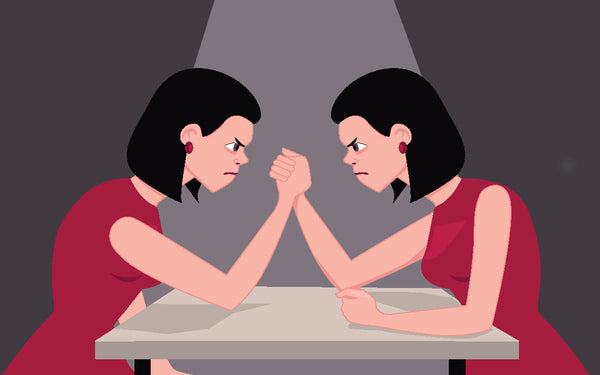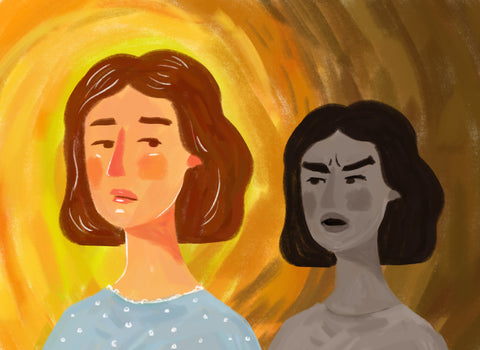Inside Job: Transforming Characters Through Internal Conflict

By Michelle Barker
Characters are the beating heart of any novel. Your reader won’t care what happens in your story if they don’t care about who it’s happening to, so your first job as a writer is to make us care. We care about people we’re connected to, which means it’s critically important to create connection. Let us get to know these people. Show us who they are by what they do, how they feel, and why it matters: action, emotion, and stakes.
Where does internal conflict come into this? It’s the buried vein of gold. It’s the why behind what a character decides to do and how they feel about it—and possibly even why it matters.
But sometimes it’s a bit confusing to get a handle on.
What is conflict?
Let’s start with a definition from author Angela Ackerman: “conflict is a force that stands between your characters and what they want most.”
It follows that external conflict is an external force blocking your character from getting what they want: a disagreeable boss, the economy, a rival. In which case, internal conflict is an internal force blocking them: a belief, a misbelief, a flaw, a fear. It can be a conflict between two internal things, such as a dilemma or a want versus need. You can also use competing desires: wanting two things that are mutually exclusive, or wanting something that goes against a strong belief or tradition. Creating that impossible emotional situation.
But it can also just be one thing, as long as whatever you choose is powerful enough to prevent your protagonist from doing what they must to achieve their goal.
Confused yet?
Let’s look at Katniss Everdeen from The Hunger Games.
Katniss is a rebel at heart. She’s self-reliant, the family provider ever since her father was killed, and she feels a particular need to protect her little sister since her mother has basically checked out of life. So, when her sister is chosen to compete in the Hunger Games, Katniss jumps in to take her place without thinking twice.
What does she want? To return to her family alive.
In order to do this, however, she will need to win the Hunger Games. Which means she will have to kill people.
During the novel’s stasis, she shows herself to be resourceful—a skilled hunter who, while not especially emotional, has compassion for people. Whatever her family doesn’t eat, she gives to others in her district where starvation is a common occurrence. Most of the skills she’s honed to survive in daily life will come in handy in the games. But compassion is something she believes she’ll have to put on the backburner if she wants to make it out alive. Showing any kind of weakness in front of the camera is a death sentence—and it seems clear that when it comes to survival, compassion is a weakness. The games are all about individuality and a survival of the fittest mentality.
The external conflict is clear: it’s the other contestants in the Hunger Games, although that shifts over time to reveal the larger overall conflict of the trilogy: Katniss and the districts versus the Capitol.
The internal conflict is Katniss’s belief (misbelief) that she must deny who she is in order to survive. She must behave in a way that goes against everything she believes in.
Suzanne Collins puts her protagonist in an impossible situation both emotionally and ethically. There’s no winning here for Katniss. No matter what she does, something is not going to work out for her. Even if she wins the games, it means she’ll have murdered a whole lot of people and quite probably damaged herself.
THAT is the buried vein of gold. If you can get your character into an emotional tight spot like this, you’ve found a powerful inner conflict.
Give your character an internal barrier
That’s really all an internal conflict is: something the protagonist has created or that has formed over time to prevent them from achieving their goal. Adding that internal barrier is what enriches your story and develops character. External barriers are not enough. If that’s all you have, you’ll give the reader a character who serves mostly as a plot construct; someone who goes through the motions in order for the external story to move forward. It will feel shallow, and the characters will likely seem stereotypical or generic.
They won’t feel like real people because they aren’t.
Use the information in your character questionnaires
You know all those long lists of questions you downloaded off the internet and faithfully answered… and then set aside? Take another look at them. If you’ve given your character a fear of heights but then haven’t given them a goal that involves the thirty-seventh floor of an unfinished building or, you know, Mount Everest, then that fear will function merely as window-dressing. It’s not doing any work for you. It’s information, and we won’t care about it because it doesn’t matter to the character.
All those secrets, fears, flaws, and moral failings you’ve dreamed up for your protagonist must be relevant to what they want if you’re planning to use them as internal conflicts.
Or... if you haven't yet developed your protagonist with character questionnaires, check these out:
- Backstory
- Psychology and Motivation
- Relationship Arcs
- Strengths and Flaws
- Voice and Expression
- Minor Character Questionnaire

Dilemmas are also good
To make this work, you need to know what your character believes—truly, with all their heart—and then put them in a situation where their beliefs come into conflict with what they want and/or need.
Fear is also a good source of inner conflict because it will prevent your main character from taking the necessary steps to get what they want or need. At the root of fear there is always a belief (or misbelief) that the feared thing will destroy you.
A misbelief about the world can form an effective internal barrier to your protagonist achieving their narrative goal. Don’t be confused by the idea of a misbelief. What it really is, to your protagonist, is a strongly held view about how the world works. They don’t see it as wrong or misguided at all. It’s a useful tool in the characterization toolbox because it ensures that whatever your protagonist wants will cause trouble for them, and it most certainly won’t solve their story problem. Because what they want will likely not be what they need. However…
Want vs need might not be enough
The tricky thing about want vs need is that your protagonist might not know what they need. Sometimes they do, like Boromir in Lord of the Rings who wants to be the hero to his father and his people but also knows he needs to support Frodo. But quite often they don’t: like Eleanor Oliphant, in Eleanor Oliphant is Completely Fine. The protagonist dreams of a romance with a musician she’s never met, but she has no idea that in order to create actual connection with anyone, she must come to terms with a past she has been actively blocking out.
Eleanor Oliphant wants connection and romance, but she goes about getting it the wrong way and with the wrong person. Her way of solving the problem won’t work until she comes to terms with her past. This very past is what causes her to isolate herself and creates eccentricities that make connection with other people difficult. Connection with others means making herself vulnerable, but she wants to feel safe and secure—which means protecting herself. She can’t have both.
Make it an inside job
Whatever you decide, if you give your protagonist an internal conflict, they will feel authentic to the reader, and you will create an essential connection between reader and protagonist that is at the heart of all engaging stories.

Michelle Barker is an award-winning author and poet. She is the co-author of two craft books: Immersion and Emotion: The Two Pillars of Storytelling and Story Skeleton: The Classics. Her fiction, non-fiction, and poetry have appeared in literary reviews worldwide. She has published three YA novels (one fantasy and two historical fiction), a historical picture book, and a chapbook of poetry. Michelle holds a BA in English literature (UBC) and an MFA in creative writing (UBC). Many of the writers she’s worked with have gone on to win publishing contracts and honours for their work. Michelle lives and writes in Vancouver, Canada.







